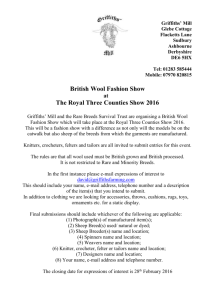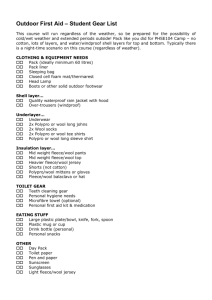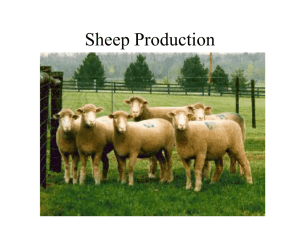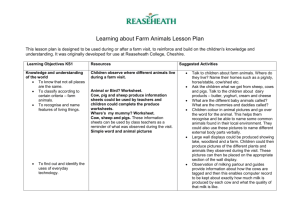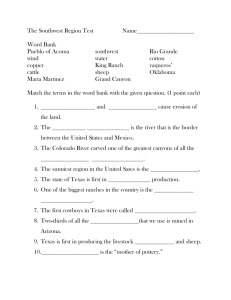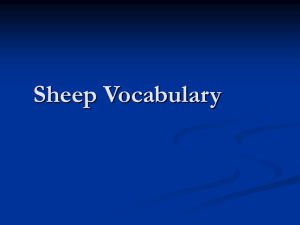Made From Animals - Oklahoma State 4-H
advertisement
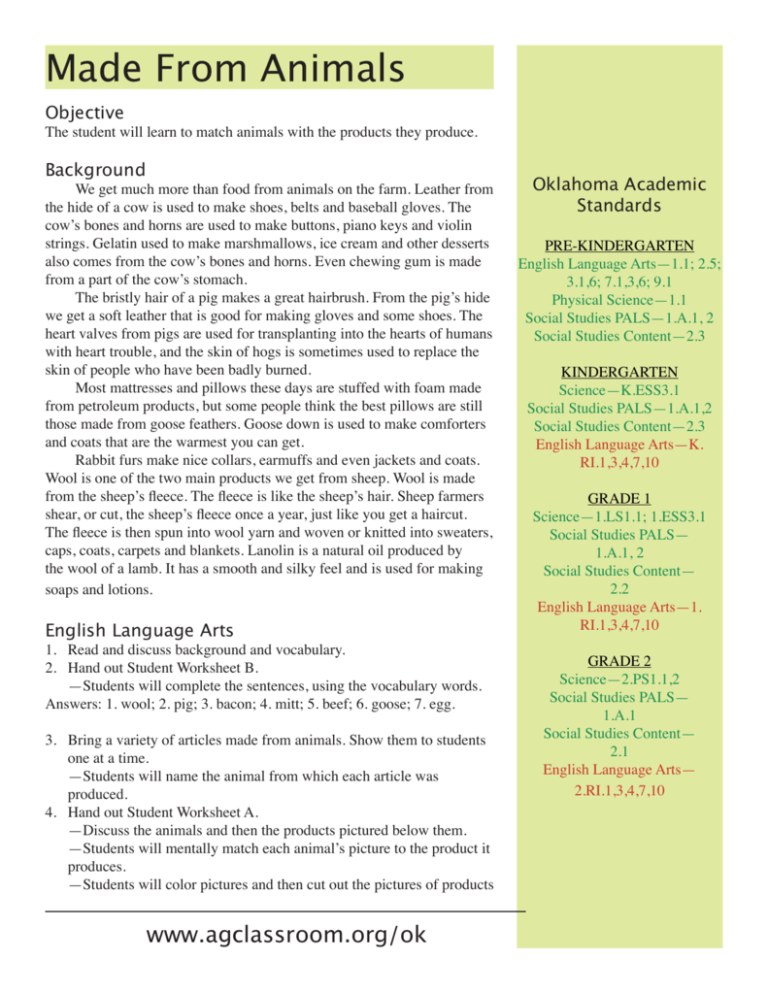
Made From Animals Objective The student will learn to match animals with the products they produce. Background We get much more than food from animals on the farm. Leather from the hide of a cow is used to make shoes, belts and baseball gloves. The cow’s bones and horns are used to make buttons, piano keys and violin strings. Gelatin used to make marshmallows, ice cream and other desserts also comes from the cow’s bones and horns. Even chewing gum is made from a part of the cow’s stomach. The bristly hair of a pig makes a great hairbrush. From the pig’s hide we get a soft leather that is good for making gloves and some shoes. The heart valves from pigs are used for transplanting into the hearts of humans with heart trouble, and the skin of hogs is sometimes used to replace the skin of people who have been badly burned. Most mattresses and pillows these days are stuffed with foam made from petroleum products, but some people think the best pillows are still those made from goose feathers. Goose down is used to make comforters and coats that are the warmest you can get. Rabbit furs make nice collars, earmuffs and even jackets and coats. Wool is one of the two main products we get from sheep. Wool is made from the sheep’s fleece. The fleece is like the sheep’s hair. Sheep farmers shear, or cut, the sheep’s fleece once a year, just like you get a haircut. The fleece is then spun into wool yarn and woven or knitted into sweaters, caps, coats, carpets and blankets. Lanolin is a natural oil produced by the wool of a lamb. It has a smooth and silky feel and is used for making soaps and lotions. English Language Arts 1. Read and discuss background and vocabulary. 2. Hand out Student Worksheet B. —Students will complete the sentences, using the vocabulary words. Answers: 1. wool; 2. pig; 3. bacon; 4. mitt; 5. beef; 6. goose; 7. egg. 3. Bring a variety of articles made from animals. Show them to students one at a time. —Students will name the animal from which each article was produced. 4. Hand out Student Worksheet A. —Discuss the animals and then the products pictured below them. —Students will mentally match each animal’s picture to the product it produces. —Students will color pictures and then cut out the pictures of products www.agclassroom.org/ok Oklahoma Academic Standards PRE-KINDERGARTEN English Language Arts—1.1; 2.5; 3.1,6; 7.1,3,6; 9.1 Physical Science—1.1 Social Studies PALS—1.A.1, 2 Social Studies Content—2.3 KINDERGARTEN Science—K.ESS3.1 Social Studies PALS—1.A.1,2 Social Studies Content—2.3 English Language Arts—K. RI.1,3,4,7,10 GRADE 1 Science—1.LS1.1; 1.ESS3.1 Social Studies PALS— 1.A.1, 2 Social Studies Content— 2.2 English Language Arts—1. RI.1,3,4,7,10 GRADE 2 Science—2.PS1.1,2 Social Studies PALS— 1.A.1 Social Studies Content— 2.1 English Language Arts— 2.RI.1,3,4,7,10 Materials articles made from animals—leather belt, bag or shoe; wool scarf, sweater or mittens; down pillow; boar bristle brush (materials listed below are optional) feathers and down from poultry animals fleece from sheep, alpaca or llama rawhide wool yarn Vocabulary boar—a male pig bristle—a short stiff hair or something like a hair down—a covering of soft fluffy feathers fleece—the woolly coat of an animal (as a sheep) gelatin—gummy or sticky protein obtained by boiling animal tissues and used as food, in photography, and in medicine leather—animal skin prepared for use transplant—to transfer (an organ or tissue) from one part or individual to another valve—a bodily structure (as in a vein or the heart) that closes temporarily to prevent passage of material or that allows movement of a fluid in one direction only wool—the soft wavy or curly usually thick undercoat of various mammals and especially sheep and glue them next to the pictures of the appropriate animals. Answers: lamb—wool sweater; pig—hairbrush (bristles); chicken—egg; beef cow—baseball mitt; goose—down feather pillow; rabbit—rabbit fur earmuffs. 5. Make a bulletin board, using pictures of farm animals as the center. —Place pictures or drawings of animal products around the board. —Using yarn, attach the product to the animal that produces it. Science 1. Bring goose feathers and ink to class. —Students will use the quills from feathers for writing. 2. Bring soaps and lotions containing lanolin for students to handle. If possible, bring unwashed raw wool for students to feel and compare with the feel of the soaps and lotions. —Discuss why humans would want to use lanolin on their skin. Social Studies 1. Lead a discussion based on the following: —Describe the basic needs of food, clothing, and shelter that are common to all people. How do animals help meet these needs? —Define and explain the role of the farmer as the producer and us as the consumer. What animal products do we consume? —How are farmers paid for their products? What do we use to purchase the products? Extra Reading Arnosky, Jim, I’m a Turkey!, Scholastic, 2009. Gibbons, Gail, Pigs, Holiday House, 2003. Green, Emily, Farm Animals: Sheep, Bellweather, 2007. Llewellyn, Claire, Milk: What’s for Lunch, Franklin Watts, 2003. Lyon, George Ella, Weaving the Rainbow, Atheneum/Richard Jackson, 2004. Murphy, Andy, Out and About at the Dairy Farm, Picture Window, 2004. Peterson, Cris, Clarabelle: Making Milk and So Much More, Boyds Mills, 2007. Seeger, Laura Vaccaro, First the Egg, Roaring Brook, 2007. www.agclassroom.org/ok Name___________________________________________________ Made From Animals Color the pictures. Cut out the animal products. Glue the product next to the animal from which it was made. rabbit lamb pig chicken goose beef cow wool sweater hairbrush egg ear muffs baseball mitt pillow Oklahoma Ag in the Classroom is a program of the Oklahoma Cooperative Extension Service, the Oklahoma Department of Agriculture, Food and Forestry and the Oklahoma State Department of Education. Name___________________________________________________ Made From Animals Use the vocabulary words to fill in the blanks. 1.My grandmother knitted my sweater from a sheep’s ___________. 2.My favorite hairbrush is made from the bristle of a ____________. 3.We ate _________ from a pig for breakfast. 4.My brother’s baseball _______ is made from the hide of a beef steer. 5.Our hamburgers come from _____ cattle, too. 6.My brothers were throwing pillows, and there were __________feathers everywhere. 7.The chicken laid an _________, and I ate it. Vocabulary pig chicken goose wool egg mitt feather beef bacon Oklahoma Ag in the Classroom is a program of the Oklahoma Cooperative Extension Service, the Oklahoma Department of Agriculture, Food and Forestry and the Oklahoma State Department of Education.

